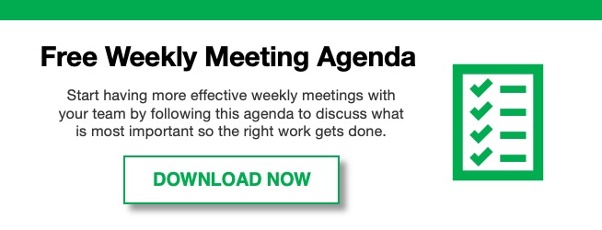“I can’t wait to get out of this meeting to get my real work done!” 
“I’m in back to back meetings. I won’t get anything done today!"
Sound familiar? According to Inc.com, most meetings are not productive; “In fact, executives consider more than 67% of meetings to be failures.” Ouch - when you consider the amount of time and money your company spends on meetings, this is even more painful. This same Inc.com article sites that “15% of an organization’s collective time is spent in meetings” and “more than $37 billion per year is spent on unproductive meetings.”
How productive are your meetings? Is your company or team on the wrong side of these stats? Why meetings are not productive can be traced to many sources, continue reading to find out how to fix your bad meetings.
Here are some tell-tale signs that bad meetings are killing productivity on your team:
- Multitasking: Are people checking their emails or catching up on other, non-related work during your meeting? Inc.com says “92% of survey respondents confessed to multitasking during meetings."
- Failure to include all participants: Do you have team members who don’t speak up during meetings? Do you have team members who tend to interrupt or dominate the conversation? If so, you are missing the diverse perspectives you need to make the best decisions and creating an unproductive meeting environment. According to Fast Company, "It’s not enough just to bring a more diverse workforce in through your doors. You need to get everybody talking–meaningfully, collaboratively, and regularly–in order to make it all worthwhile from a business standpoint."
- Remote participants are checked out: Do you know if your remote team members are even there on the other end of the line? For team members participating remotely, staying focused and engaged can be even more challenging. They are missing the vital nonverbal communications, making it harder to meaningfully engage. And, if your team isn’t intentional about including them, it is tempting to forget they are even there.
- Lack of structure & planning: Do you know the agenda for your meeting? Do you know what you are trying to accomplish? Why are you having the meeting in the first place? If you don’t have a strong facilitator who clearly states the purpose of the meeting, sends an agenda in advance, and sticks to the plan, your meetings are not as productive as they could be.
- Too much time focused on status updates: Are you asking your team to share things like “What have you done since our last meeting? Who did you talk to? What are the updates?” Is the majority of your meeting time spent discussing things that have already happened? If so, your meetings aren’t productive because you don’t need to share this information in person in a meeting. According to an article in Forbes, "Businesses spend too much time looking at meetings as a way to share historical information. This means that businesses spend insufficient time focused on the future and how others can help produce results.“ Your meeting time is much better spent focusing on solutions and results and making action plans for the future rather than dwelling on the details of what’s already occurred.
As you can tell from this list, these productivity killers in meetings are all related. The bottom line is that status meetings are boring - they don’t engage your team and end up wasting everyone’s time. If you were prepared ahead of time, sticking to a clear agenda, and working on solving problems collaboratively, it would be far less tempting for people to check email, clam up, or check out. The key to making your meetings more productive is to make them more engaging.
How to Make Your Meetings Productive
- Prepare & share in Advance: According to Forbes, "There is no reason for the entire team to sit in a meeting to discuss something that already happened. Read about it!” Before you go to your meeting, everyone should prepare by updating their status ahead of time and sharing with the rest of the team. Clearly indicate where you are stuck and need help or input so that the team can come prepared to tackle specific problems. Our Rhythm software platform is a perfect vehicle for this. In Rhythm, you can status all of your KPIs and Priorities Red, Yellow, or Green and make a comment to share with the team regarding any important updates. They can read these comments in advance of the meeting and even collaborate with you to jump start conversations about how to get back on track.
- Clearly state the purpose & agenda (and stick to it): We recommend starting each meeting with “This meeting will be successful if…” to clarify the objective for all participants. The facilitator should reign in conversations that don’t align with the meeting’s stated objective, start and end the meeting on time, and stick to the set agenda items to maximize the productivity of the meeting. These can be challenging facilitation skills; you can download our free Meeting Facilitation Guide for helpful tools and tips.
- Don’t forget about your virtual team: Use video to engage remote employees. If you don’t have the technical capability to do video conferencing, using a cloud-based platform like Rhythm where everyone can at least follow along together can help the remote team stay focused. Following some simple facilitation rules to include your virtual participants is also very helpful; even a rule like “remote participants always share first” can go a long way to keeping the entire team engaged.
- Focus on solutions, not status: Engage your team by doing the work together to collaborate and solve problems. According to Fast Company, "Meetings are often where hard decisions are made, where innovative ideas are shared, and where important deals are done.” It is very hard to innovate if you’re only talking about what’s already happened. Instead of a weekly status meeting with your team, consider having a weekly adjustment meeting. Share and read status updates ahead of time and come to the meeting ready to solve a problem (or problems) together. Use the time and brainpower in the room to figure out solutions together. Joint problem-solving is a heck of a lot more interesting and engaging to your team than listening to each other drone on about meetings they’ve had or people they’ve talked to, etc. In addition to engagement, you have the added benefit of walking out of the meeting with an action plan to solve a problem.
Don't fall into the expensive trap of unproductive meetings. Our Rhythm software and playbook are designed to help growing mid-market companies have more productive meetings by collaborating together, using a proven agenda, and spending time focused on adjustments rather than status. Supercharge your company's productivity by having better meetings!
Additional Rhythm Systems Meeting Resources:
How To Have Effective Weekly Staff Meetings (With Sample Agenda Template)
Download our weekly meeting agenda
Are You Having Weekly Meetings with Yourself?
Weekly Adjustment Meetings vs. Weekly Status Meetings (Infographic)
Consider using Rhythm Software to run your weekly meeting, where the status and agenda are automatically created every week to keep you on track!
Photo Credit: iStock by Getty Images




